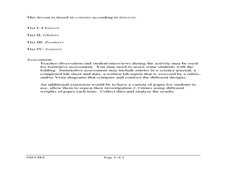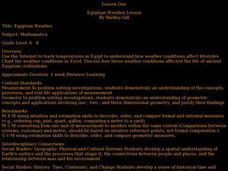Curated OER
Origami Flight: The Physical Setting
Sixth graders investigate the forces that move certain objects. In this physics lesson, 6th graders design and create paper flying objects using origami methods, which they practice flying in different conditions. Students record and...
Curated OER
Physics: Forces and Motion
Students recognize the effect of Earth's gravity on an object's weight. In this force and motion lesson students understand the role of gravity when you drop an object. Students experiment with small items. Students measure in Newton's....
University of Wisconsin
What’s a Square Foot Anyway? Laying Out the Design Plan
Clever! Participants don square-foot cardboard shoes to mark out the rain garden plot that they have spent the last few weeks designing. In this way, they are practicing scale modeling as well! Note that this lesson is part of a unit,...
Curated OER
Don’t Sit Under the Apple Tree…You Might Become Famous
Students explore Newton's laws using CEENBoTs. In this physics lesson, students collect data and create tables and graphs. They calculate speed, acceleration and forces using mathematical formulas.
Teach Engineering
May the Force Be with You: Weight
Too much material will weigh you down. The sixth segment in a series of 22 highlights how weight affects a plane. Pupils learn that engineers take the properties of materials, including weight, when designing something.
Curated OER
Racquetball With Math
Students explore physical education by participating in a game with their class. In this number sense lesson, students utilize their motor skills while performing a music version of racquetball. Students utilize math skills by...
Curated OER
Egyptian Weather Lesson
Young scholars chart temperatures in Egypt on spreadsheet to determine how weather conditions affect lifestyles.
Curated OER
Shapes (Orienteering)
Students explore the tools of navigation. In this shapes lesson, students navigate using direction cues to create a shape. Students follow specific steps to create their shapes. Students use compasses to see the directions they are...
Curated OER
How Does Your Garden Grow?
Students construct and maintain a school garden. In this gardening lesson, students plan the construction of the garden by writing letters to local businesses asking for supplies and materials; students build the garden using their math...
Center of Excellence for Science and Mathematics Education
A Sick Astronaut
Aspiring astronauts graph, interpret, and analyze data. They investigate the relationship between two variables in a problem situation. Using both graphic and symbolic representations they will grasp the concept of line of best fit to...
Curated OER
Deep Sea Drilling
Students explore ocean vessels that drill the ocean floor. In this ocean drilling lesson, students watch videos about drilling the ocean floor and discuss. Students get into groups, go outside and use string to mark off the amount of...
Curated OER
Cost Effective Egg Drop
Students create cost effective ways to protect an egg. In this cost conscious lesson plan, students complete an egg drop activity while spending the least amount of money possible.
Teach Engineering
Let's Learn About Spatial Viz!
Can you see your class working on spatial visualization? The first installment of a five-part module introduces the concept of spatial visualization and provides a 12-question diagnostic assessment to test spatial visualization skills....
Curated OER
How Does Your Garden Grow?
Students create a design for a school garden. In this garden design lesson plan, students analyze what plants grow best in their school's climate and work in teams to design a garden. Students measure the existing space, determine the...
Curated OER
Forces on the Human Molecule
Learners conduct several simple lab activities to explore the five fundamental load types that can act on structures: tension, compression, shear, bending, and torsion. In this activity, students play the role of molecules in a beam...
Curated OER
Balloonautics
Young scholars are introduced to basic aerodynamics through a discussion of thrust and drag and a hands-on activity. They examine the forces of thrust, drag, air pressure, aerodynamic shapes and Newton's Third Law Of Motion.
Curated OER
Filling the Glass (Water, Air, and Fractions)
Learners predict which of two glasses is 1/2 full using visual estimation, height measurement, and liquid measurement methods. Mathematical equations to accurately solve the problem are determined and verified.
Curated OER
Leaping Lemurs! How far can you jump?
Students watch a segment of the PBS video which show the lemurs' ability to jump. In pairs, students collect measurement data involving each other's length of a standard step, a standing broad jump, and a long jump. They record their...
Curated OER
Probability: The Study of Chance
Students practice the basic principles of probability by conducting an experiment, determining if a game is fair, collecting data, interpreting data, displaying data, conducting analysis, and stating and applying the rule for probability.
Curated OER
Calculate Your Contribution
Young scholars assess the environmental impact of their transportation choices. They keep a transportation journal and use a website to calculate vehicle emissions for themselves and their class. They evaluate their transportation choices.





















